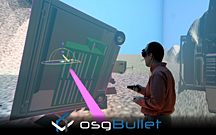- Number 317 |
- August 2, 2010
Ames Laboratory scientists develop real-time vertical engineering design software

Software application that helps
create high-resolution, real-time, 3-D
computer simulations, called osgBullet.
Researchers at DOE’s Ames Laboratory recently won a 2010 R&D 100 Award for a software application that helps create high-resolution, real-time, 3-D computer simulations, called osgBullet.
Lead scientists on the project were Mark Bryden, program director of Ames Laboratory’s Simulation, Modeling and Decision Science research program and an associate professor of mechanical engineering at Iowa State University and Doug McCorkle, associate scientist with both Ames Laboratory and ISU’s Virtual Reality Applications Center. Co-developers of osgBullet sharing the R&D 100 Award include the U.S. Army Armament Research, Development and Engineering Center, Rock Island, Ill..; the U.S. Department of Energy’s National Energy Technology Laboratory, Morgantown, W. Va.; the U.S. Department of Energy’s Idaho National Laboratory, Idaho Falls, Idaho; and Skew Matrix Software, Louisville, Colo.
The osgBullet software tool integrates highly detailed 3-D drawings with physics engines, which are software tools that accurately mimic how objects and materials interact in the real world. Thanks to osgBullet, engineers can polish their designs in a real-time computed environment. According to Bryden and McCorkle, “osgBullet allows engineers to play ‘what if?’ games” during the design process – changing materials or trying different parts – all in a virtual environment, in precise detail, and very quickly.
“In the past, you had to take a computer-aided design file and simplify it by removing detail,” such as bolts in structures and other small elements of renderings, McCorkle continued, a process that might require two or three weeks of an engineering team’s time. “And that’s just for a truck design not a power plant design,” he said.
Now, osgBullet allows users to quickly insert their production CAD designs in their full complexity without having to simplify and modify the production CAD. Eventually, the goal is to enable design engineers to use the virtual world to fit together different components and incorporate the complex physics of each so that they can create a dynamic simulation of the entire system, such as the exhaust gas recirculation system of a power plant, Bryden explained.
Bryden and McCorkle released osgBullet as open-source software, which makes the tool accessible to small businesses that otherwise could not purchase costly simulation applications. More than 500 users have downloaded osgBullet since its release in October 2009.
OsgBullet is available for download at http://osgbullet.vesuite.org/. Funding to support osgBullet is provided by the U.S. Army Armament Research, Development and Engineering Center and the U.S. Department of Energy’s National Energy Technology Laboratory.
[Mark Ingebretsen, 515.294.3474,
marki@ameslab.gov]
